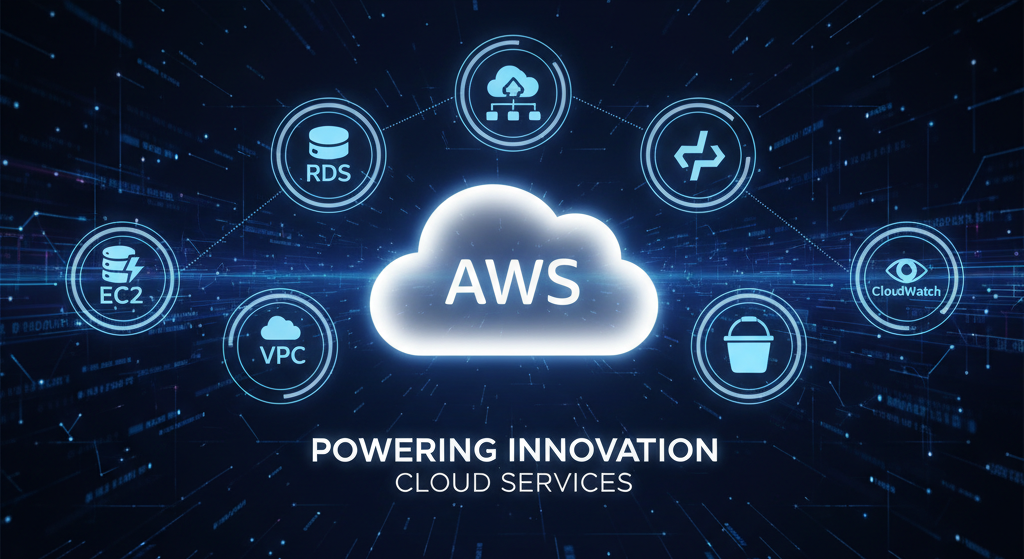The cloud has revolutionized how businesses operate, and Amazon Web Services (AWS) stands at the forefront of this transformation. From startups to global enterprises, organizations are leveraging AWS to build, deploy, and scale their applications with unprecedented agility and efficiency. But with hundreds of services, understanding where to begin can be daunting.
This guide cuts through the complexity, providing a clear, accessible overview of the fundamental AWS services that form the backbone of modern cloud infrastructure. Whether you're new to cloud computing or looking to solidify your foundational knowledge, this AWS 101 will equip you with the essential understanding to navigate the AWS system.
Understanding the Fundamentals of AWS
Think of AWS as a giant, flexible toolkit for building anything online. It offers you computing power, storage space, databases, and more, all over the internet. This frees companies from buying and maintaining their own physical servers. Instead, you pay for what you use, when you use it. This focus on utility is a big reason why AWS leads the cloud market.
What is Amazon Web Services (AWS)?
Amazon Web Services (AWS) is a broad collection of cloud computing services. It provides on-demand resources and tools for businesses of all sizes. AWS aims to help people build complex, scalable applications much faster. With data centers spread across the globe, AWS ensures your applications are close to your users. This means better speed and reliability for everyone.
Key Cloud Computing Concepts (IaaS, PaaS, SaaS)
Cloud services come in a few basic types. First, Infrastructure as a Service (IaaS) gives you the basic building blocks like virtual servers and storage. AWS EC2 is a prime example of IaaS. Then there's Platform as a Service (PaaS), which offers a complete environment for developing and running apps without managing the underlying hardware. Finally, Software as a Service (SaaS) delivers fully functional applications directly to users over the web, like Gmail or Salesforce. AWS provides options for all these models, giving you lots of choices.
The AWS Global Infrastructure: Regions and Availability Zones
AWS spreads its services across many different parts of the globe. These distinct geographic areas are called Regions. Each Region has several isolated locations inside it, known as Availability Zones. Availability Zones are physically separate but connected by fast, low-latency links. This setup helps your applications stay online even if one zone has an issue, making your services more reliable and fault-tolerant. It also lets you place resources closer to your customers for faster response times.
Compute Services: Powering Your Applications
Running applications needs computing power. AWS offers several ways to get this power, from virtual servers you control to code that runs without you managing any servers at all. These services make sure your apps always have the resources they need to perform well.
Amazon Elastic Compute Cloud (EC2)
Amazon EC2 gives you virtual servers, or "instances," in the cloud. You can choose different instance types based on your needs for CPU, memory, storage, and networking capacity. EC2 lets you quickly start or stop these servers, scaling up or down as your traffic changes. This flexibility is key for handling busy times. Many companies like Netflix use EC2 instances to run their massive streaming services, delivering shows to millions of viewers every day.
AWS Lambda: Serverless Computing
AWS Lambda changes how you think about servers. With Lambda, you upload your code, and AWS runs it only when needed. You do not manage any servers yourself; AWS handles all the underlying infrastructure. This "serverless" model is great for event-driven tasks, like processing image uploads or sending email notifications. You only pay for the compute time your code uses, down to the millisecond.
- Tip: Consider Lambda for tasks that run only now and then, or for smaller pieces of your app that react to events. If your app needs constant, long-running servers, EC2 might be a better fit.
Container Services: Elastic Container Service (ECS) and Elastic Kubernetes Service (EKS)
Containers package your application code and its dependencies into a single unit. This makes them easy to move and run consistently across different environments. AWS provides two main container services. Amazon Elastic Container Service (ECS) is a fully managed service for running containers. It works well if you want a simpler way to manage your containerized apps. Amazon Elastic Kubernetes Service (EKS) lets you run Kubernetes, an open-source system for managing containerized applications, on AWS. EKS offers more control and flexibility for those already familiar with Kubernetes.
Storage Services: Storing and Accessing Your Data
Every application needs a place to store data. AWS offers a wide range of storage options, from simple files to complex databases, ensuring your data is always safe and accessible. These services are built for high durability and performance.
Amazon Simple Storage Service (S3)
Amazon S3 provides object storage for pretty much anything you can imagine. Think of it as unlimited storage for files, images, videos, and data backups. You can access your stored items from anywhere on the internet. S3 is known for its incredible reliability. It is designed for 99.999999999% durability over a year. Many websites host their static files directly on S3, and it is a popular choice for creating data lakes and storing backups.
Amazon Elastic Block Store (EBS)
Amazon EBS offers block storage volumes that attach directly to your EC2 instances. Imagine it like a hard drive connected to a computer. These volumes are designed for applications that need fast, consistent access to data. You can choose different EBS volume types based on your performance needs, like SSD-backed volumes for high-speed databases or HDD-backed volumes for larger, less frequently accessed data.
Amazon Relational Database Service (RDS)
Amazon RDS simplifies setting up, operating, and scaling a relational database. It manages many of the tedious tasks for you, like backups, patching, and scaling. RDS supports several popular database engines, including MySQL, PostgreSQL, Oracle, SQL Server, and MariaDB. This service helps countless companies run their main application databases without worrying about server upkeep.
Networking Services: Connecting Your Resources
Connecting your cloud resources securely and efficiently is crucial. AWS networking services let you build your own private network in the cloud, control traffic, and manage domain names. They form the unseen infrastructure that makes everything else work.
Amazon Virtual Private Cloud (VPC)
Amazon VPC lets you create a private, isolated section of the AWS Cloud. Here, you launch AWS resources in a virtual network that you define. You control your virtual networking environment, including IP address ranges, subnets, route tables, and network gateways. This is like having your own data center in the cloud, but with all the AWS benefits. You can then add security groups, which act like firewalls for your individual instances.
- Tip: Design your VPC with separate subnets for different purposes, like public-facing web servers and private database servers. Use security groups to allow only necessary traffic, greatly boosting your network security.
Elastic Load Balancing (ELB)
Elastic Load Balancing (ELB) automatically distributes incoming application traffic across multiple targets. These targets could be EC2 instances, containers, or even IP addresses. ELB boosts the availability and fault tolerance of your applications. If one server fails, the load balancer simply sends traffic to the healthy ones. AWS offers different types of ELB, like Application Load Balancers for HTTP/HTTPS traffic and Network Load Balancers for extreme performance.
Amazon Route 53
Amazon Route 53 is a highly available and scalable cloud Domain Name System (DNS) web service. DNS is like the phonebook of the internet, translating easy-to-read domain names (like example.com) into numerical IP addresses. Route 53 lets you register domain names and route internet traffic to your websites and applications. It also offers advanced traffic management policies, helping you direct users to the best performing resources.
Databases: Managing Structured and Unstructured Data
AWS offers a robust set of database services, ready for nearly any kind of data. Whether you need traditional tables or flexible document stores, you can find a service that fits your project. These services handle much of the heavy lifting for you, so you can focus on your applications.
Amazon Relational Database Service (RDS) - Revisited
As we talked about before, Amazon RDS helps you run managed relational databases. It takes care of common tasks like setting up, patching, and backups. RDS also makes it easy to create read replicas, which are copies of your database that handle read-heavy traffic, further improving your application's performance and availability. This means your main database can focus on writing new data.
Amazon DynamoDB
Amazon DynamoDB is a fast and flexible NoSQL database service. It is designed for applications that need consistent, single-digit millisecond response times at any scale. DynamoDB supports both document and key-value data models, making it very versatile. Many mobile, web, gaming, and IoT applications use DynamoDB for its incredible speed and ability to handle massive amounts of data and user traffic without slowing down.
Amazon Aurora
Amazon Aurora is a MySQL and PostgreSQL-compatible relational database built for the cloud. It combines the speed and availability of high-end commercial databases with the simplicity and cost-effectiveness of open-source ones. AWS states that Aurora delivers up to five times the throughput of standard MySQL and three times the throughput of standard PostgreSQL. Aurora is fully managed by RDS, offering high performance and high availability.
Security and Identity Management: Protecting Your Cloud Environment
Keeping your cloud resources safe is super important. AWS provides powerful tools to control who can do what and to protect your data. These services are the foundation of a secure cloud setup.
AWS Identity and Access Management (IAM)
AWS IAM is the service you use to securely control access to AWS resources. You can define users, groups, and roles, then attach policies to them. These policies specify exactly what actions a user or service can perform on which resources. For example, you can give one developer full access to EC2 instances, but only read access to S3 storage.
- Tip: Always follow the principle of least privilege with IAM. Give users and services only the permissions they absolutely need to do their job, and nothing more. This greatly reduces your security risks.
AWS Security Groups and Network Access Control Lists (NACLs)
Security groups and Network Access Control Lists (NACLs) are like virtual firewalls for your AWS network. A Security Group acts as a firewall for one or more EC2 instances. It controls traffic to and from the instances. NACLs, on the other hand, act as stateless firewalls for subnets. They control traffic entering and leaving a subnet. Security groups are stateful, meaning if you allow outbound traffic, the return inbound traffic is automatically allowed. NACLs are stateless, so you must explicitly allow both inbound and outbound rules.
AWS Key Management Service (KMS)
AWS Key Management Service (KMS) helps you easily create and control the encryption keys used to encrypt your data. It is a managed service that makes it simple to add encryption to your applications and services. KMS integrates with many other AWS services, allowing you to encrypt your data at rest and in transit without much effort. This adds an important layer of protection for your sensitive information.
Conclusion: Your Next Steps in the AWS Journey
You have now explored the core services that make up the backbone of AWS cloud computing. We covered virtual servers with EC2, managed storage with S3 and EBS, and network isolation with VPC. You also learned about efficient data handling with RDS and DynamoDB, along with crucial security measures like IAM and Security Groups. These fundamental services are where most cloud projects begin.
The best way to solidify your understanding is to start building. AWS offers a Free Tier, letting you experiment with many of these services at no cost. Dive into the AWS documentation or check out online training resources to deepen your skills. The AWS platform is always growing, with new features and services launching regularly. Keep learning and experimenting, and you will find yourself mastering this powerful cloud system quickly.

